Analyzing Brand Sentiment with Robinhood, Gamestop & R
Brands are essential. They live in our minds as ideas and each person constantly interacts with hundreds of brands a day, sometimes positively, sometimes negatively. But what is their role in data science? Well given most tech is fueled by strong business brands, it is probably essential for any data scientist to have even a basic an understanding of brands. In this post, I want to explain how to do a simple brand sentiment analysis using Twitter.






